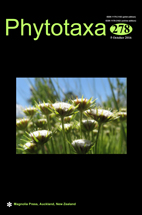Abstract
Specimens from southeastern and southern Brazil previously identified as Sheathia arcuata (= Batrachospermum arcuatum) are shown to be members of the recently described genus Nocturama, previously known only from Australia and New Zealand. Morphological and molecular evidence support recognizing the Brazilian specimens as a new species, described here as Nocturama novamundensis, sp. nov. Comparison of DNA sequences of the plastid-encoded ribulose-1,5-bisphosphatecarboxylase–oxygenase large subunit (rbcL) and the nuclear small subunit ribosomal DNA (SSU rDNA) markers showed Nocturama as a well supported clade. The sequence divergences between the new and the type species were high (95-98bp, 7.4–7.6%) for rbcL and 19bp, 1.1% for SSU), and those within each species were extremely low (0-1 bp, 0-0.1%). The new species can be distinguished from N. antipodites in having curved primary fascicles composed of non-‘audouinelloid’ cells (compared to straight primary fascicles with audouinelloid—cylindrical—cells) and in being always dioecious (only rarely is N. antipodites dioecious).

